 11-27-2014, 01:18 PM
11-27-2014, 01:18 PM
|
#1 (permalink)
|
|
EcoModding Lurker
Join Date: Jan 2012
Location: Jackson, Michigan
Posts: 57
Thanks: 1
Thanked 63 Times in 22 Posts
|
experimental engine dyno project
Some of you folks may remember my three cylinder G10 powered Miata from a few years ago. While that project was an overall success, it had limitations. Moving forward, I took what I learned from the G10 project and built a B3 powered Miata. The B3 engine is a 1300cc 63HP SOHC powerplant from a Ford Festiva. Although similar to the Mazda 323 and Ford Aspire engine, the Festive engine has a few components that allow a better fit in a Miata chassis.
The B3 project has covered 50K miles and returns an average MPG of low to mid 40's. This is real world MPG and no special driving procedures are done. The car is equipped with A/C, power steering and a full interior. The transmission was modified for a slightly taller 5th gear to reduce cruise speed RPMs. Tipping the scales at 2260 lbs the car isn't too heavy but it also not light weight.
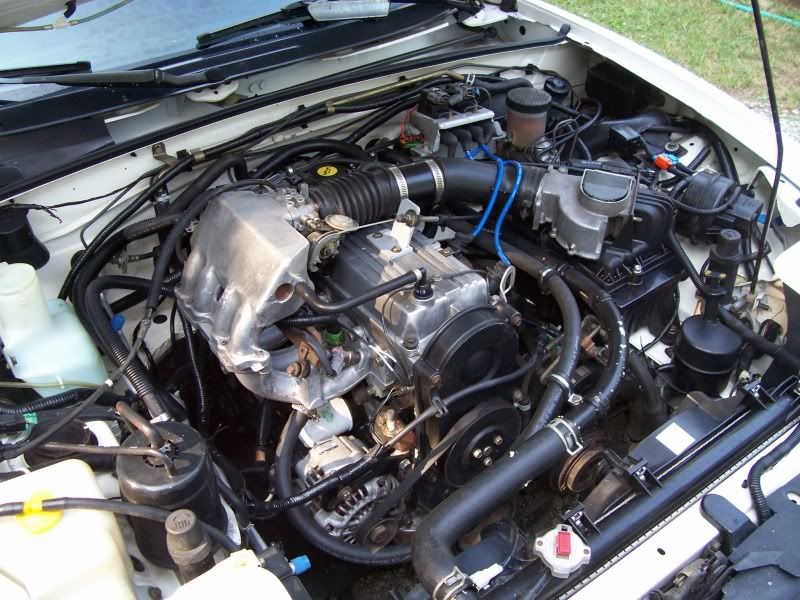 The Miata with a Festiva B3 engine. So far the car has covered 50,000 miles.
The Miata with a Festiva B3 engine. So far the car has covered 50,000 miles.
My original goal was to get an average of 50MPG and after almost two years of struggling it was clear that I would need an engine dyno to develop and test modifications that will work in the real world. .... so I built an engine dyno.
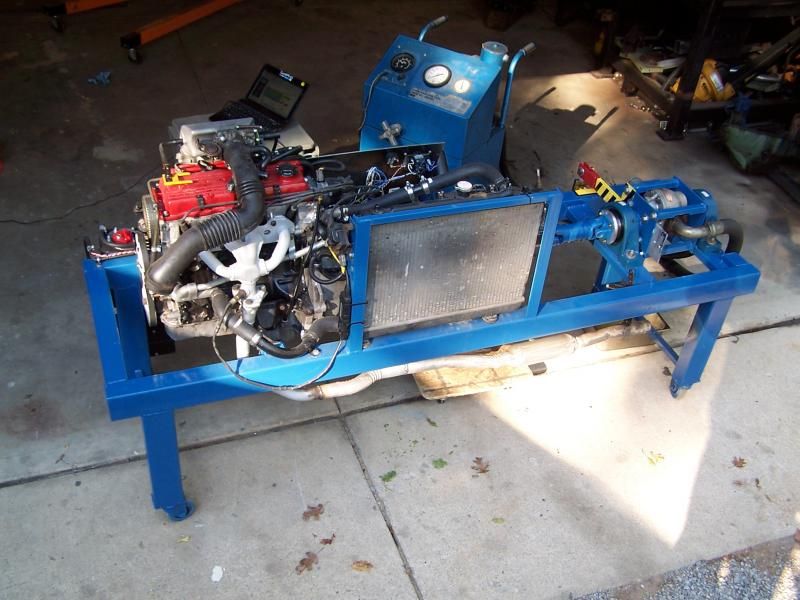 the dyno
the dyno
This dyno was set up to develop engine tunes for the 2000-4000 rpm range Focusing on the cruise speed sweet spot is my intention. Experimental tests are semi limited to a maximum of 20 minutes of run time because of cooling issues.
The power absorber is a hydraulic pump mounted on trunions and is equipped with a torque arm and load cell. The load is electronically measured and adjusted every few seconds so the temperature and viscosity of the hydraulic fluid is automatically compensated for.
A Megasquirt II is being used for engine management and real-time data gathering. Eventually I'll add more instrumentation as budget allows.
The B3 engine is an eight valve lump that develops more torque than horsepower. it's vastly different than the modern multi-valve engines so not all the experiments will translate to modern engines.
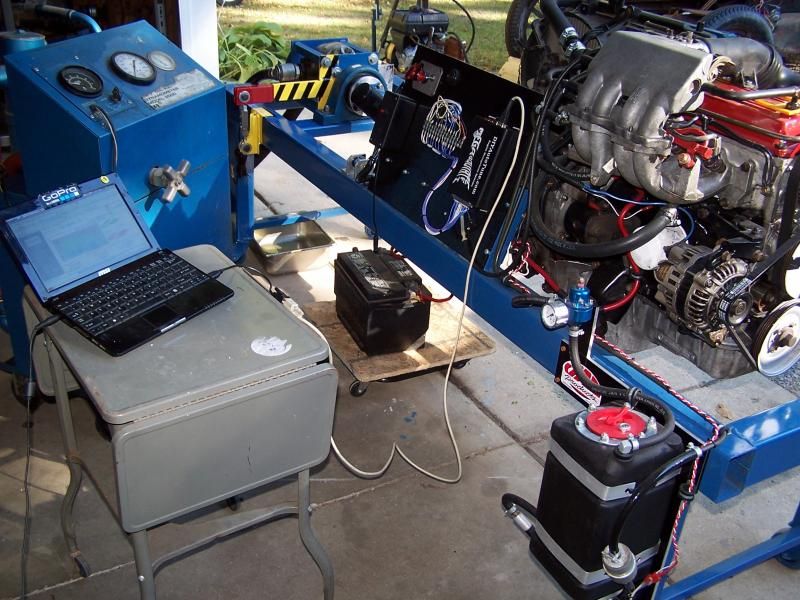
As you can see in the pictures, this dyno was built with an identical drivetrain that is being used in the B3 Miata.
The dyno has taken almost six months of evenings and weekends construct and the build is in its finial stages. I'm currently focusing on software and data gathering hardware at the moment. I expect to have the odds and ends sorted out within the next few weeks.
Because of the dyno, I would like to focus this build thread on engine modifications. The dyno will allow rapid development and testing of ideas and if the ideas prove out they will be incorporated in the B3 Miata. Right now the Miata is more or less off the road for the rest of the winter and we won't see any real world results until spring.
I hope to get some feedback from anyone interested in following this project. I'm looking for ideas to test on the dyno. Anything from conventional mods to down the rabbit hole stuff. The only limitation is this is an extremely low budget project. The good news is I can fabricate almost anything so most of the custom machine work won't add too much to the budget.
Here are some videos of the progress..
Mazda B3 first start engine Dyno - YouTube
Mazda B3 engine dyno first load test. - YouTube
B3 engine dyno control test... making torque! - YouTube
For more info in the Miata build, Google "B3 Miata"
For more info in the dyno build, Google "B3 dyno"
I look forward to hearing your comments and ideas of what we can test. Please keep in mind that this is an engine development thread and although aero mods save fuel, they don't work on a dyno. 
Jim
__________________
G10 powered Mazda MX5 45+ MPG(sold)
B3 powered Mazda MX5 40+ MPG
|
|
|

|
|
The Following 18 Users Say Thank You to fujioko For This Useful Post:
|
Ardent (11-27-2014), Daox (11-28-2014), darcane (12-09-2015), dirtydave (01-08-2015), dvldrmmr (12-04-2014), Ecky (12-04-2014), Gasoline Fumes (11-29-2014), Joggernot (11-29-2014), Joris (11-27-2014), JRMichler (11-27-2014), MetroMPG (11-27-2014), oldtamiyaphile (11-28-2014), P-hack (11-28-2014), pgfpro (11-27-2014), Piwoslaw (12-11-2015), RustyLugNut (12-05-2014), user removed (11-27-2014), Xist (11-27-2014) |
 Today Today
|
|
|
|
 Other popular topics in this forum...
Other popular topics in this forum...
|
|
|
|
 11-27-2014, 01:52 PM
11-27-2014, 01:52 PM
|
#2 (permalink)
|
|
Corporate imperialist
Join Date: Jul 2011
Location: NewMexico (USA)
Posts: 11,312
Thanks: 273
Thanked 3,580 Times in 2,843 Posts
|
I think this is very cool.
This is what every engine modder wished they had.
To fix the cooling issue most dyno users have a huge cooling reservoir to cool the engine. Some even have roof mounted cooling tower.
Or is it the dyno brake hydraulics that are over heating?
How about once and for all confirm the gains of an alternator delete.
Just power the engine with an external battery and unhook the alternator and see what the reduction of engine drag does to fuel consumption.
Try building your self a water methanol injection setup. I don't think it will increase fuel economy beyond the added BTU value of the alcohol but it could increase your power for passing or hill climbing if you have such a requirement.
http://ecomodder.com/wiki/index.php/Water_injection
If you want to go down the rabbit hole, test an HHO cell.
Because the number 1 thing the HHO believes all claim is that they cant put their HHO cell on an engine that's on a dyno for some reason. They never have time or money but always claim it gets them 20% better fuel mileage.
Since you don't know anything about building an HHO cell (something only a true believer knows) they should send you one to test, so they cant say "you built it wrong" after it doesn't work.
__________________
1984 chevy suburban, custom made 6.5L diesel turbocharged with a Garrett T76 and Holset HE351VE, 22:1 compression 13psi of intercooled boost.
1989 firebird mostly stock. Aside from the 6-speed manual trans, corvette gen 5 front brakes, 1LE drive shaft, 4th Gen disc brake fbody rear end.
2011 leaf SL, white, portable 240v CHAdeMO, trailer hitch, new batt as of 2014.
Last edited by oil pan 4; 11-27-2014 at 02:02 PM..
|
|
|

|
|
The Following 3 Users Say Thank You to oil pan 4 For This Useful Post:
|
|
 11-27-2014, 02:19 PM
11-27-2014, 02:19 PM
|
#3 (permalink)
|
|
Master EcoModder
Join Date: Sep 2012
Location: Motor City
Posts: 282
Thanks: 0
Thanked 224 Times in 138 Posts
|
How are you measuring fuel flow? Some sort of flow meter? Or the old gas can on a scale method?
Pretty cool project. Any idea what kind of power you can absorb? Can you actually get to peak power?
|
|
|

|
 11-27-2014, 02:27 PM
11-27-2014, 02:27 PM
|
#4 (permalink)
|
|
EcoModding Lurker
Join Date: Jan 2012
Location: Jackson, Michigan
Posts: 57
Thanks: 1
Thanked 63 Times in 22 Posts
|
Hi 'ya Oil pan,
You're correct the cooling issue can be fixed fairly easily and probably will get sorted out before long. The hydraulic tank has a heat exchanger made for a garden hose. Unfortunately I can't run a garden hose in Michigan during the winter.
The alternator delete is an excellent idea and will defiantly be tested. Ideas like that will be videoed and posted on YouTube.
HHO qualifies as a rabbit hole experiment and of course deserves to be tested.
I forgot to include some info on the dyno engine...
The dyno engine is more or less stock. It was completely disassembled, cleaned, but not rebuilt. As I recall it has about 170K miles. The only new parts were the hydraulic valve lash adjusters and new gaskets. The cylinder head was shaved .010 (ten thousandths) for a slight bump in compression.
Here are some other ideas that will be tested this winter. Hopefully we can get some fresh ideas in the loop.
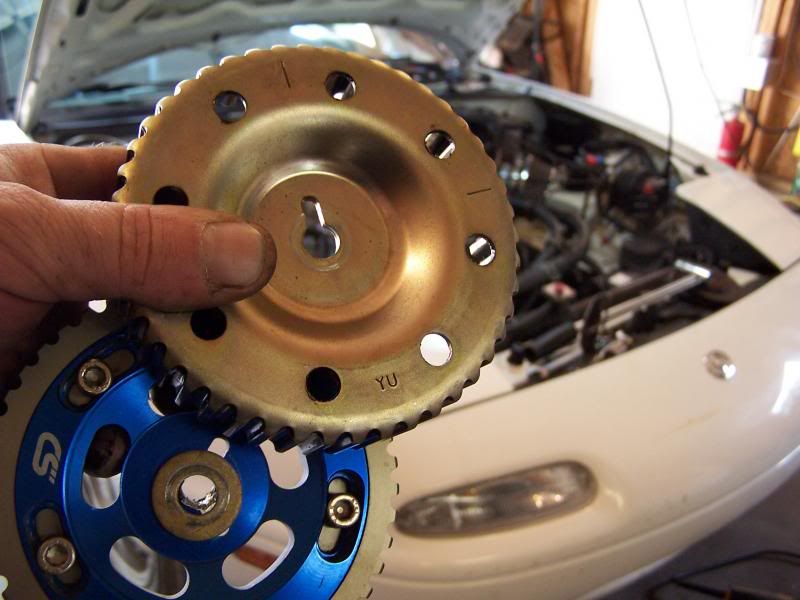 Advancing or retarding the camshaft with an adjustable sprocket.
Advancing or retarding the camshaft with an adjustable sprocket.
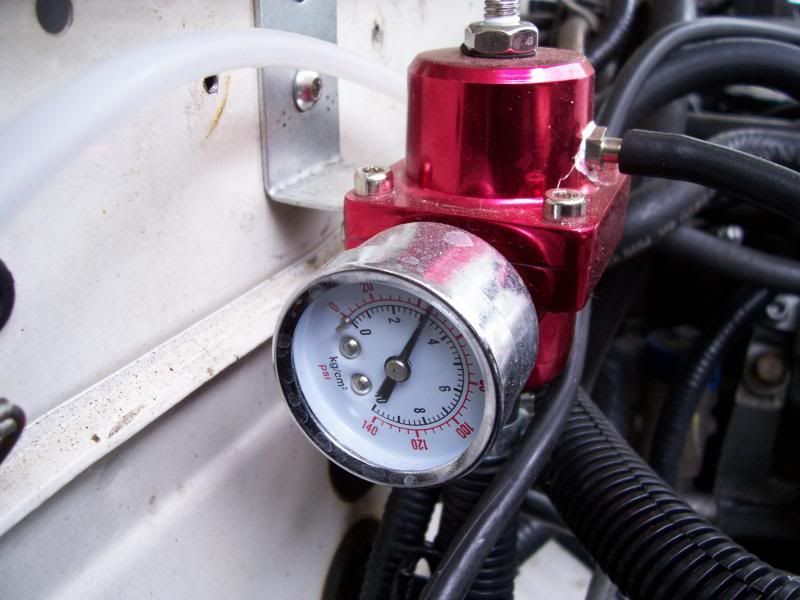 adjusting the fuel pressure
adjusting the fuel pressure
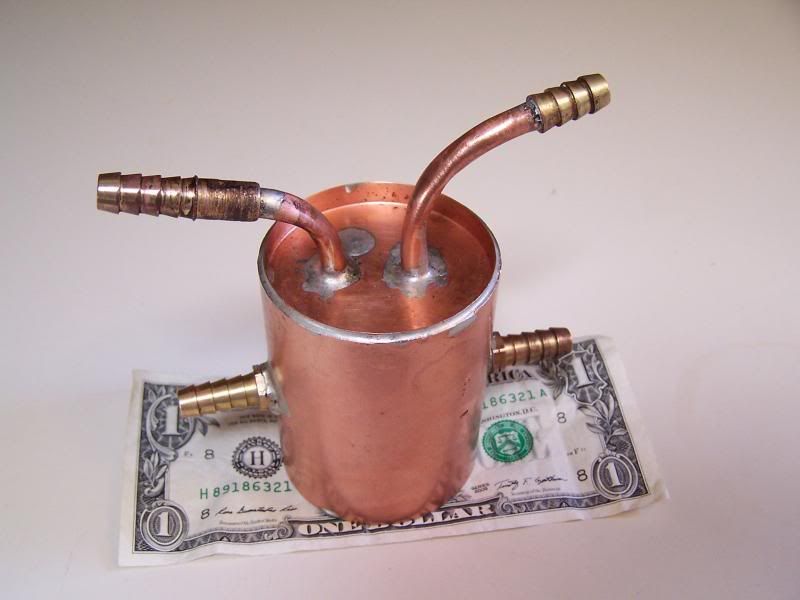 gasoline heat exchanger
gasoline heat exchanger
Plus many more!
Jim
__________________
G10 powered Mazda MX5 45+ MPG(sold)
B3 powered Mazda MX5 40+ MPG
Last edited by fujioko; 11-27-2014 at 03:25 PM..
|
|
|

|
|
The Following 4 Users Say Thank You to fujioko For This Useful Post:
|
|
 11-27-2014, 02:39 PM
11-27-2014, 02:39 PM
|
#5 (permalink)
|
|
EcoModding Lurker
Join Date: Jan 2012
Location: Jackson, Michigan
Posts: 57
Thanks: 1
Thanked 63 Times in 22 Posts
|
Quote:
Originally Posted by ennored

How are you measuring fuel flow? Some sort of flow meter? Or the old gas can on a scale method?
Pretty cool project. Any idea what kind of power you can absorb? Can you actually get to peak power?
|
I have two methods to measure fuel consumption. The first is the megasquirt data... certainly very convenient but not completely reliable.
The second method is to run a fifth fuel injector into a vessel and at the end of a test the vessel would be weighed. The results then multiplied by four for total fuel consumption. The fifth injector would have its own driver circuit so it wouldn't load down the engine injector circuit.
The hydraulic portion of the dyno was originally intended for marine engines and can absorb 200+ HP. I had to change the pump and a few other things
but I suspect the dyno is still capable of absorbing 70 or 80 HP.
Jim
__________________
G10 powered Mazda MX5 45+ MPG(sold)
B3 powered Mazda MX5 40+ MPG
|
|
|

|
 11-27-2014, 04:18 PM
11-27-2014, 04:18 PM
|
#6 (permalink)
|
|
Corporate imperialist
Join Date: Jul 2011
Location: NewMexico (USA)
Posts: 11,312
Thanks: 273
Thanked 3,580 Times in 2,843 Posts
|
I have seen gasoline fuel heaters and they usually don't seem to produce any results, it turns out most engine designs are really good at mixing air and fuel and burning them completely.
Warmed intake air on the other hand tends to work quite well on most engines.
Here is something you might try:
http://ecomodder.com/forum/showthrea...ler-29085.html
Its simply a faster warm up and a way to stay at operating temp. I am sure you know your cold start fuel economy versus your warmed up fuel economy. This reduces the time between the two and keeps the engine warm with the heater blasting.
__________________
1984 chevy suburban, custom made 6.5L diesel turbocharged with a Garrett T76 and Holset HE351VE, 22:1 compression 13psi of intercooled boost.
1989 firebird mostly stock. Aside from the 6-speed manual trans, corvette gen 5 front brakes, 1LE drive shaft, 4th Gen disc brake fbody rear end.
2011 leaf SL, white, portable 240v CHAdeMO, trailer hitch, new batt as of 2014.
|
|
|

|
 11-27-2014, 05:20 PM
11-27-2014, 05:20 PM
|
#7 (permalink)
|
|
Master EcoModder
Join Date: Aug 2012
Location: northwest of normal
Posts: 29,154
Thanks: 8,277
Thanked 9,039 Times in 7,470 Posts
|
Not much to say about tests, but I wanted to say something nice about the build quality. It's nice. Is that an actual fuel cell? It needs a bank of capacitors to replace that battery.
Will it accommodate engines other than the B3?
|
|
|

|
 11-27-2014, 06:18 PM
11-27-2014, 06:18 PM
|
#8 (permalink)
|
|
Master EcoModder
Join Date: Feb 2011
Location: Phillips, WI
Posts: 1,018
Thanks: 192
Thanked 467 Times in 287 Posts
|
Wow. You are hard core. I'm too lazy to be that ambitious.
A study of intake air temperature vs fuel flow vs torque for a range of typical RPM's would be good. The torque should encompass the range from WOT right down to zero. This would be good data for warm air intakes.
I also would like to see real dyno data for camshaft timing. The data should include the full range of torque from zero to WOT for the RPM's tested.
A garden hose is useable in cold weather. You just need to store it indoors and start the water flow immediately after hooking it up.
__________________
06 Canyon: The vacuum gauge plus wheel covers helped increase summer 2015 mileage to 38.5 MPG, while summer 2016 mileage was 38.6 MPG without the wheel covers. Drove 33,021 miles 2016-2018 at 35.00 MPG.
22 Maverick: Summer 2022 burned 62.74 gallons in 3145.1 miles for 50.1 MPG. Winter 2023-2024 - 2416.7 miles, 58.66 gallons for 41 MPG.
|
|
|

|
 11-27-2014, 07:25 PM
11-27-2014, 07:25 PM
|
#9 (permalink)
|
|
EcoModding Lurker
Join Date: Jan 2012
Location: Jackson, Michigan
Posts: 57
Thanks: 1
Thanked 63 Times in 22 Posts
|
Wow, lots of questions!,
In reply to freebeard,
The dyno is more or less made for any Mazda B series engine. The only limit is some engines may develop too much power for the dyno to adsorb. I suppose other smaller engines could be adapted down the road.
in reply to JRMichler,
I have to double check, but I believe the hydraulic pump used for adsorbing power is limited to 4000 rpm or less. The B3 makes peak HP at 5000 RPM. Selecting a lower gear in the transmission should keep the pump out of the danger zone but at this point I'm not sure if I can really do WOT pulls. Time will tell. For now it is safe to say 4K dyno pulls are are more or less the cap on this setup. My focus is in the realistic daily driving RPM range.
The gasoline heat exchanger pictured is something I fabricated last year. My on the road testing indicated that the warmer fuel reduced MPG's . I think it's another rabbit hole experiment but it should be an interesting test.
The intake air temp is another experiment that will get done this winter. The B3 Miata really loves cold air and I did some experiments by bypassing the throttle body heat and found a bunch of power. On the other side of the heat scale I plumbed in a liquid to air heat exchanger. The Miata engine snorkeled +170F air 100% of the time. The car ran like crap and and lost a bunch of power. I'm sure there is a happy medium or some tricks that can be done.
 The B3 Miata snorkeling uber hot air through a heat exchanger. I got the idea from another forum and gave it a try. This is definitely a dyno experiment in the near future
The B3 Miata snorkeling uber hot air through a heat exchanger. I got the idea from another forum and gave it a try. This is definitely a dyno experiment in the near future
So far the list is: - Camshaft timing
- hot/cold air
- hot gasoline
- fuel pressure
- Spark plug indexing
- HHO (if supplied)
- Alternator delete
- + a few more from my list that I can't find.
Thanks for the comments and feel free to keep adding to the idea list.
Jim
__________________
G10 powered Mazda MX5 45+ MPG(sold)
B3 powered Mazda MX5 40+ MPG
|
|
|

|
 11-27-2014, 08:43 PM
11-27-2014, 08:43 PM
|
#10 (permalink)
|
|
Batman Junior
Join Date: Nov 2007
Location: 1000 Islands, Ontario, Canada
Posts: 22,536
Thanks: 4,082
Thanked 6,985 Times in 3,616 Posts
|
Too cool!
I'd also suggest:
--> Experiment with increased EGR (cooled, preferably). Find the limit of driveability.
--> Quantify efficiency gains from an electrically driven water pump.
--> Got an extra set of valve springs? Likely too small to be seen on a dyno, but some efficient engine designs run with reduced spring tension.
Also, I'm sure you know this, but the warm air intake is *supposed* to reduce engine power. The wider throttle opening required to produce a given amount of power is where the supposed efficiency gain is found (reduced throttling losses). Similar, in a way, to EGR. Unless it messes too much with other factors (timing, in some cases).
|
|
|

|
|
The Following User Says Thank You to MetroMPG For This Useful Post:
|
|
|